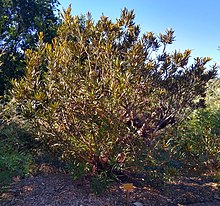
New Caledonia is a sui generis collectivity of overseas France in the southwest Pacific Ocean, south of Vanuatu, about 1,210 km (750 mi) east of Australia, and 17,000 km (11,000 mi) from Metropolitan France. The archipelago, part of the Melanesia subregion, includes the main island of Grande Terre, the Loyalty Islands, the Chesterfield Islands, the Belep archipelago, the Isle of Pines, and a few remote islets. The Chesterfield Islands are in the Coral Sea. French people, especially locals, call Grande Terre le Caillou, a nickname also used more generally for the entire New Caledonia. Pro-independence Kanak parties use the name (la) Kanaky to refer to New Caledonia, a term coined in the 1980s from the ethnic name of the indigenous Melanesian Kanak people who make up 41% of New Caledonia's population. New Caledonia is one of the European Union's Overseas Countries and Territories (OCTs), but it is not part of the European Union.

The geography of New Caledonia (Nouvelle-Calédonie), an overseas collectivity of France located in the subregion of Melanesia, makes the continental island group unique in the southwest Pacific. Among other things, the island chain has played a role in preserving unique biological lineages from the Mesozoic. It served as a waystation in the expansion of the predecessors of the Polynesians, the Lapita culture. Under the Free French it was a vital naval base for Allied Forces during the War in the Pacific.

New Caledonia is a major source for nickel and contains roughly 10% of the world's known nickel supply. The islands contain about 7,100,000 tonnes of nickel. With the annual production of about 107,000 tonnes in 2009, New Caledonia was the world's fifth largest producer after Russia (266,000), Indonesia (189,000), Canada (181,000) and Australia (167,000). In recent years, the economy has suffered because of depressed international demand for nickel due to the 2007-2008 global financial crisis. Only a negligible amount of the land is suitable for cultivation, and food accounts for about 20% of imports. In addition to nickel, the substantial financial support from France and tourism are keys to the health of the economy. In the 2000s, large additions were made to nickel mining capacity. The Goro Nickel Plant is expected to be one of the largest nickel producing plants on Earth. This plant produces an estimated 20% of the global nickel supply. However, the need to respond to environmental concerns over the country's globally recognized ecological heritage, may increasingly need to be factored into capitalization of mining operations.

Nouméa is the capital and largest city of the French special collectivity of New Caledonia and is also the largest francophone city in Oceania. It is situated on a peninsula in the south of New Caledonia's main island, Grande Terre, and is home to the majority of the island's European, Polynesian, Indonesian, and Vietnamese populations, as well as many Melanesians, Ni-Vanuatu and Kanaks who work in one of the South Pacific's most industrialised cities. The city lies on a protected deepwater harbour that serves as the chief port for New Caledonia.

Grevillea, commonly known as spider flowers, is a genus of about 360 species of evergreen flowering plants in the family Proteaceae. Plants in the genus Grevillea are shrubs, rarely trees, with the leaves arranged alternately along the branches, the flowers zygomorphic, arranged in racemes at the ends of branchlets, and the fruit a follicle that splits down one side only, releasing one or two seeds.

Boulouparis is a commune in the South Province of New Caledonia, an overseas territory of France in the Pacific Ocean.

Grevillea bipinnatifida, commonly known as fuchsia grevillea, is a species of flowering plant in the family Proteaceae and is endemic to the south-west of Western Australia. It is a spreading shrub, usually with bipinnatifid leaves and loose clusters of dull pink to crimson flowers.
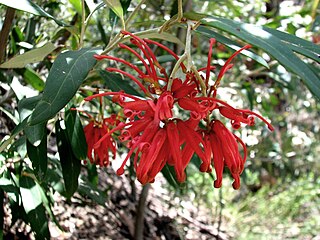
Grevillea victoriae, also known as royal grevillea or mountain grevillea, is a species of flowering plant in the family Proteaceae and is endemic to mountainous regions of south-eastern continental Australia. It is an erect to spreading shrub with elliptic to lance-shaped leaves, and pendulous clusters of red to orange flowers.

Grevillea treueriana, also known as Mount Finke grevillea or scarlet grevillea, is a species of flowering plant in the family Proteaceae and is endemic to Mount Finke in South Australia. It is a shrub with pinnatisect leaves with 3 to 7 lobes, the end lobes linear and sharply pointed, and bright scarlet flowers on one side of the floral rachis.

Grevillea manglesii is a species of flowering plant in the family Proteaceae and is endemic to an area around Perth in Western Australia. It is a spreading shrub with divided leaves, with triangular or linear lobes, and clusters of cream-coloured or white flowers.
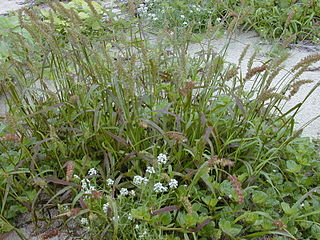
Cenchrus echinatus is a species of grass known by the common names southern sandbur, spiny sandbur, southern sandspur, and in Australia, Mossman River grass. It is native to North and South America. It is a clump-forming annual grass growing up to 80 cm (31 in) tall. The leaves occur with or without hairs and measure up to 12 mm (0.47 in) wide. The ligule is a fringe of hairs. The grass has barbed burrs of 4–10 mm (0.16–0.39 in) long.

Grevillea alpivaga, also known as buffalo grevillea, is a species of flowering plant in the family Proteaceae and is endemic to a restricted area of Victoria, Australia. It is a shrub with crowded, linear leaves and pale green creamy-white flowers.

Metrosideros operculata is a species of flowering plant in the family Myrtaceae. It is endemic to New Caledonia. It usually grows as a shrub to 3 metres in height, or rarely as a small tree to 10 metres. Stems are square in section and covered with silky hairs. The stiff, pointed leaves have a slightly revolute margin and are linear to elliptic in shape. They are 12 to 40 mm long and 3 to 10 mm wide. White, pink or red flowers with 3 petals and between 50 and 120 stamens are produced in axillary inflorescences.

Le Mont-Dore is a commune in the suburbs of Nouméa in the South Province of New Caledonia, an overseas territory of France in the Pacific Ocean.
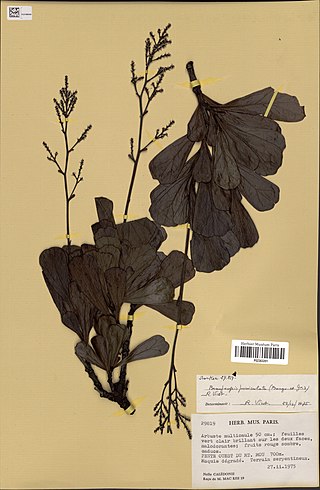
Beaupreopsis is a genus of flowering plants in the family Proteaceae, with just one species in the genus, Beaupreopsis paniculata. It is native to New Caledonia on the south of Grand Terre. Its habitat is from open maquis, to mountain area as low scrub, on a substrate of eroded ultramafic rocks.
Grevillea meisneri is a shrub in the family Proteaceae. It is endemic to New Caledonia. It is a manganese accumulator.

Grevillea gillivrayi is a shrub or small tree in the family Proteaceae. It is endemic to New Caledonia.
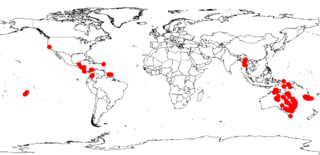
Hugh Shaw MacKee previously known as Hugh Shaw McKee was a botanist who was born in Northern Ireland, but who collected in Australia and Oceania, and finally in New Caledonia, where together with his wife and other collaborators, he collected over 46,000 specimens.
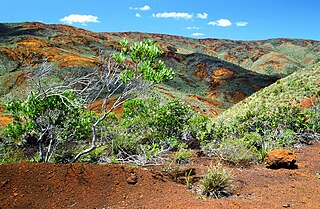
Mining maquis is a type of shrubland biome. It forms on ultramafic rock as a result of forest cover retreat due to repeated wildfires. It is common on New Caledonia.
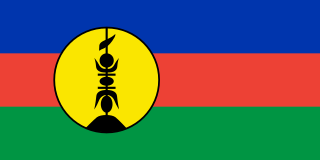
Miss New Caledonia is a French beauty pageant which selects a representative for the Miss France national competition from the sui generis overseas collectivity of New Caledonia. The first Miss New Caledonia was crowned in 1952, although the pageant was not held regularly until 1980. Until 2007, the competition was known as Miss Caledonia.
